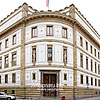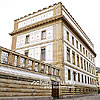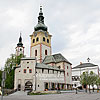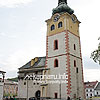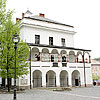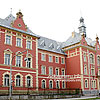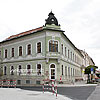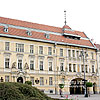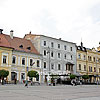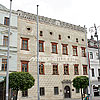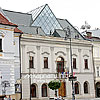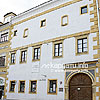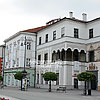Banská Bystrica
Banská Bystrica is a city in central Slovakia. It is the capital of Banská Bystrica region and Banská Bystrica district. The city, which population is more than 85,000 people, is located on Hron river, in the valley surrounded by mountain ranges: Kremnica mountains (Kremnické vrchy), Slovak Ore mountains (Slovenské rudohorie), Great Fatra (Veľká Fatra) mountain range and Staré Hory mountains.
The settlement located at the foot of Urpín mountain was fist mentioned in the document of Hungarian king Béla IV. He granted the settlement of German miners (came mainly from Thuringia) extensive municipal privileges (1255). Nowadays this document is kept in the regional museum of local lore.
Banská Bystrica appeared on the crossroads of trade routes, but the most important role in its development belongs to the production of non-ferrous metals. First gold was found there, then copper which made the city famous across the whole Europe. At the turn of the XVIth century Juraj Thurzo, the rich citizen of Kraków city, and Jakob Fugger, the famous Augsburg merchant, founded 'The Trading Community', which delivered copper from Banská Bystrica to all European markets. The Fugger dynasty organized and controlled the process of production, processing and sales of ore. Trying to get maximum profit, Fuggers reduced the wages, which led to the mine workers rebellion in 1525-1526. The mining lasted untill coal seams depleted (XVIIIth century).
In 1725 the first clothing manufacture was opened. In the XIXth and at the beginning of the XXth centuries the city industry rapidly developed and the railway was built. In August 1944 Slovak National Uprising, one of the largest anti-Nazi resistance events in Europe, was launched in Banská Bystrica. The insurgents aimed to liberate the country and create an independent Slovak state. However, the Soviet troops concentrated in the Carpathians, were slow to support Slovaks and the uprising was brutally suppressed by the German forces. As a result, more than 30,000 people died till the end of 1944.
Nowadays Banská Bystrica is one of the most popular tourist destinations in central Slovakia. In addition to the rich historical and cultural heritage, there are more than 500 km of tourist routes for different types of tourism developed around the city. The city and its surroundings have a well-developed tourism infrastructure. Nearby Banská Bystrica city such resorts as Donovaly ski resort (Donovaly village) and Brusno SPA (Brusno village) are located.
Architectural monuments
- Barbican and the city defensive walls (XVIth century)
- Matthias house or Matejov dom (1479)
- Banská Bystrica city castle or Banská Bystrica hrad (XIIth-XVth centuries)
- Church of the Assumption of the Virgin Mary or Kostol Nanebovzatia Panny Márie (1255, XIVth cent., 1761, 1770)
- Jesuit сhurch of St. Francis Xavier or Jezuitský kostol svätého Františka Xaverského (XVIIIth century)
- Church of the Holy Cross or Kostol sv. Kríža (1492, 1782)
- Marian column (1719)
- The palace of Radvaňsky family or Kaštieľ Radvanských (XVIth-XVIIth centuries)
- Town Hall (XVIth century)
- The remains of Barchyjovsky family palace or Bárczyovský kaštieľ (XVIIth century)
- Tikhanovsky manor house or Tihányiovský kaštieľ (XIXth century)
- Turzovsky house or Thurzo's house (XVth-XVIth centuries)
Museums
- Slovak National Uprising museum
- Central Slovakian museum

 Ukraine
Ukraine Poland
Poland Slovakia
Slovakia
 Українською
Українською